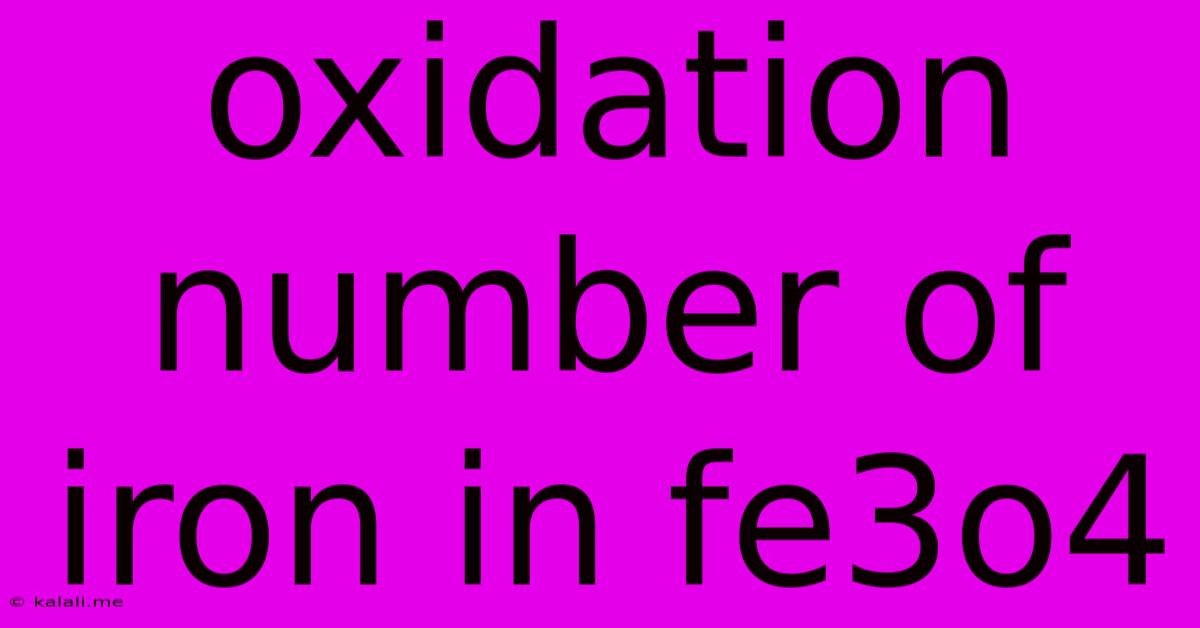Oxidation Number Of Iron In Fe3o4
Kalali
Jun 13, 2025 · 3 min read

Table of Contents
Determining the Oxidation Number of Iron in Fe₃O₄
This article will delve into the fascinating chemistry behind determining the oxidation number of iron in the mixed-valence oxide, Fe₃O₄, also known as magnetite. Understanding this concept is crucial for various fields, including materials science, electrochemistry, and inorganic chemistry. The seemingly simple formula belies a more complex reality, revealing a mixed oxidation state for iron.
What is an Oxidation Number?
Before we tackle Fe₃O₄, let's briefly review the concept of oxidation numbers. An oxidation number, also known as oxidation state, represents the hypothetical charge an atom would have if all bonds to atoms of different elements were 100% ionic. It's a useful tool for balancing redox reactions and understanding the electron distribution within a compound. Note that oxidation numbers are not necessarily the real charges on atoms.
The Challenge of Fe₃O₄
Magnetite, Fe₃O₄, presents a unique challenge because iron exists in two different oxidation states within the same compound. This is a common feature of mixed-valence compounds. Simply averaging the oxidation states won't provide an accurate picture. We need to employ a systematic approach.
Determining the Oxidation States in Fe₃O₄
The key to solving this lies in understanding the structure of magnetite and applying the rules for assigning oxidation numbers. Fe₃O₄ can be viewed as a combination of two simpler oxides: FeO and Fe₂O₃. This is a simplification, but it helps in understanding the oxidation states present.
-
In FeO (Iron(II) oxide): Oxygen has an oxidation number of -2. Since the compound is neutral, the iron must have an oxidation number of +2 to balance the charge. Therefore, iron in FeO is in the +2 oxidation state.
-
In Fe₂O₃ (Iron(III) oxide): Again, oxygen has an oxidation number of -2. To balance the charge in Fe₂O₃, each iron atom must have an oxidation number of +3. Therefore, iron in Fe₂O₃ is in the +3 oxidation state.
-
Combining the Oxides: We can represent Fe₃O₄ as FeO·Fe₂O₃. This shows that the compound contains both Fe²⁺ and Fe³⁺ ions. To confirm this, let’s consider the overall charge balance in the formula unit Fe₃O₄:
The total negative charge from four oxygen atoms (4 x -2 = -8) must be balanced by the total positive charge from the iron atoms. This means that the sum of the oxidation numbers of the three iron atoms must equal +8. Let's assume 'x' iron atoms are in the +2 oxidation state and 'y' iron atoms are in the +3 oxidation state. Therefore we have:
x + y = 3 (total number of iron atoms) 2x + 3y = 8 (total positive charge from iron)
Solving these simultaneous equations gives us x = 1 and y = 2. This confirms the presence of one Fe²⁺ ion and two Fe³⁺ ions in each formula unit of Fe₃O₄.
Conclusion
Therefore, iron in Fe₃O₄ exists in two oxidation states: +2 and +3. It's not a single oxidation number, but rather a mixture of these two states. This example beautifully illustrates the complexity and fascination of inorganic chemistry and the importance of considering the chemical structure when determining oxidation numbers. Understanding the oxidation states of iron in Fe₃O₄ is fundamental to comprehending its magnetic properties and reactivity.
Latest Posts
Latest Posts
-
Greatest Common Factor Of 56 And 84
Jun 14, 2025
-
Clutch Pack Limited Slip Differential Diagram
Jun 14, 2025
-
Average Gpa At University Of Toronto
Jun 14, 2025
-
Average Act Score For Ohio University
Jun 14, 2025
-
Acceleration Occurs When An Object Undergoes
Jun 14, 2025
Related Post
Thank you for visiting our website which covers about Oxidation Number Of Iron In Fe3o4 . We hope the information provided has been useful to you. Feel free to contact us if you have any questions or need further assistance. See you next time and don't miss to bookmark.